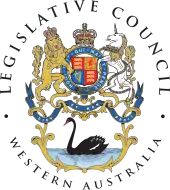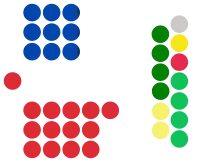Western Australian Legislative Council
The Western Australian Legislative Council is the upper house of the Parliament of Western Australia, a state of Australia. It is regarded as a house of review for legislation passed by the Legislative Assembly, the lower house. The two Houses of Parliament sit in Parliament House in the state capital, Perth.
Legislative Council | |
|---|---|
| 40th Parliament | |
 | |
| Type | |
| Type | |
| History | |
| Founded | 1832 |
| Leadership | |
Deputy President and Chair of Committees | |
Leader of the Government | |
Deputy Leader of the Government | |
Government Whip | |
| Structure | |
| Seats | 36 |
 | |
Political groups | Government (14) Labor (14) |
Length of term | 4 years |
| Elections | |
| Single transferable vote with group voting tickets | |
Last election | 11 March 2017 |
Next election | 13 March 2021 |
| Meeting place | |
| Legislative Council Chamber Parliament House, Perth Western Australia, Australia | |
| Website | |
| WA Legislative Council | |
Effective on 20 May 2005, for the election of members of the Legislative Council, the State was divided into 6 electoral regions by community of interest —3 metropolitan and 3 rural—each electing 6 members to the Legislative Council.[1][2] The 2005 changes continued to maintain the previous malapportionment in favour of rural regions. The changes took effect for the 2008 state election.
Since 2008, the Legislative Council has had 36 members. Since the 2013 state election, the terms of both houses of Parliament have been fixed four-year terms, with elections being held every four years on the second Saturday in March,[3][4] though the term of the Legislative Council not expiring until May after the election. The term of the current Legislative Council began on 22 May 2017, when members elected at the 2017 state election took their seats. The Labor Party holds 14 of the 36 seats, the Liberals hold nine seats, while the Nationals and The Greens hold four seats each and One Nation holds three seats.[5]
Six members of the Legislative Council are elected from each of the six regions under a proportional and preferential voting system using the single transferable vote method. Each council region overlaps with a varying number of Assembly seats. Because of the proportional representation system in place as well as the malapportionment in favour of rural regions, the Legislative Council has traditionally been controlled by a coalition of the Liberal and National parties, and minor parties and independents have been more easily elected.[6]
Current distribution of seats
The current composition of the Legislative Council, elected at the 2017 state election, is as follows:
| Party | Seats held | Legislative Council | |||||||||||||||||||||
|---|---|---|---|---|---|---|---|---|---|---|---|---|---|---|---|---|---|---|---|---|---|---|---|
| Labor | 14 | ||||||||||||||||||||||
| Liberal | 9 | ||||||||||||||||||||||
| Greens | 4 | ||||||||||||||||||||||
| Nationals | 4 | ||||||||||||||||||||||
| One Nation | 2 | ||||||||||||||||||||||
| Liberal Democrats | 1 | ||||||||||||||||||||||
| Shooters, Fishers, Farmers | 1 | ||||||||||||||||||||||
| Western Australia | 1 | ||||||||||||||||||||||
| Total | 36 | ||||||||||||||||||||||
- 19 votes as a majority are required to pass legislation.
History
Western Australia's first representative parliament was the Legislative Council, first created in 1832 as an appointive body. Initially it consisted only of official members; that is, public officials whose office guaranteed them a place on the Council. Three years later, an attempt was made to expand the Council by including four unofficial members to be nominated by the governor. However, the public demand for elected rather than nominated members was so great that implementation of the change was delayed until 1838.
In 1850, the British Parliament passed an act that permitted the Australian colonies to establish legislative councils that were one-third nominated and two-thirds elected, but only under the condition that the colonies take responsibility for the costs of their own government. Because of this provision, Western Australia was slow to adopt the system. In 1867, the governor responded to public demand for representative government by holding unofficial elections and subsequently nominating each elected person to the Council. Three years later, representative government was officially adopted and the Legislative Council was changed to consist of 12 elected members and 6 members nominated by the governor. Suffrage was limited to landowners and those with a prescribed level of income.
When Western Australia gained responsible government in 1890, a bicameral system was adopted and the Legislative Council became a house of review for legislation passed by the popularly elected Legislative Assembly. This Council consisted of 15 members, all nominated by the governor. However, it was provided that once the population of the colony reached 60,000, the Legislative Council would become elective. The colony was expected to take many years to reach a population of 60,000 but the discovery of the eastern goldfields and the consequent gold rush caused that figure to be reached by 1893. The constitution was then amended to make the Legislative Council an elective house of 21 seats, with three members to be elected from each of seven provinces. The first election to the Council was held following the dissolution of parliament in June 1894.
This system was retained until 1962 when, over the next two years, the Council was reformed, creating a series of two-member electorates. Members were elected for six years with provision for re-election of one every three years. Universal suffrage was also granted in order to bring the Council into line with the Assembly. This arrangement remained until 10 June 1987 when the Burke Labor government, with the conditional support of the National Party, introduced the present system of multi-member electorates and a method of proportional representation which is, however, 'weighted' to give extra representation to rural constituents. The legislation was made possible because the Australian Democrats in 1986 negotiated an election preference flow to Labor in return for an explicit undertaking on Legislative Council electoral reform, which resulted in the defeat of a number of Liberal councillors who were committed to opposing such reform.[7][8]
Until 2005 the state used a zonally weighted electoral system for both houses of parliament. In effect, this meant that the vote of a Perth voter counted for less than that of a rural voter. The difference was less marked in the Assembly than in the Legislative Council, whose metropolitan regions are numerically weighted so that up to two rural members are elected by the same number of votes needed to elect a single member from Perth. This style of weighting has not been adopted by any other Australian state.
While the Liberal Party and Labor Party were both advantaged and disadvantaged by this system, it strongly benefited the National Party. During the 1990s, Liberal Premier Richard Court considered changing the system along the lines of that in place in South Australia, but backed down in the face of National Party opposition.
Effective on 20 May 2005, for the election of members of the Legislative Council, the State was divided into 6 electoral regions by community of interest, 3 metropolitan and 3 rural, each electing 6 members to the Legislative Council.[2] The regions were defined geographically and functionally, and also included partial requirements for equal numbers of Legislative Assembly districts. However, all previously elected members remained until the following election on 6 September 2008.[2] Even with the reforms, rural areas are still significantly overrepresented. According to ABC election analyst Antony Green, the rural weighting is still significant enough that it is all but impossible for a Liberal premier in Western Australia to govern without National support, even if the Liberals win enough Legislative Assembly seats to theoretically allow them to govern alone.[9]
Malapportionment
Perth accounts for three-quarters of the state's population, while only about 35% of the state's population is located in towns and small settlements across an area of over 2.6 million square kilometres outside the Perth metropolitan area. However, until 2005 the state used a zonally weighted electoral system for both houses of parliament. In Legislative Council elections, this meant that a vote in Perth was worth, on average, only half a rural vote.
The WA Legislative Council is the last remaining State or Territory chamber in Australia to have a significant rural overweighting. The Mining and Pastoral Region, for example, has nearly a quarter the number of electors as those in the three metropolitan regions. On paper, this gives Mining and Pastoral almost six times the voting power of Perth. However, according to Green, the actual bias is greater due to historically low turnout in the Mining and Pastoral region.[10]
| Name | Electors[11] (2017) | Electors per Member |
|---|---|---|
| Agricultural | 101,229 | 16,871 |
| East Metropolitan | 362,932 | 60,488 |
| Mining and Pastoral | 96,894 | 16,149 |
| North Metropolitan | 362,608 | 60,434 |
| South Metropolitan | 377,634 | 62,939 |
| South West | 205,270 | 34,211 |
| Total | 1,506,567 | 41,849 |
Constituencies
1870–1890: Electoral districts
The Legislative Council Act 1870, which took effect the same year, created ten electoral districts for the Legislative Council, electing twelve members in total.[12] Three later acts of parliament (in 1874, 1883, and 1887) established four more electoral districts, created from the territory of existing districts.
1894–1989: Electoral provinces
In 1890, following the creation of the Legislative Assembly, the Legislative Council returned to being a completely appointed body, with 15 members. The Constitution Act Amendment Act 1893 was subsequently passed, taking effect in 1894, to provide for seven electoral provinces, each electing three members. Additional provinces were created in 1897 and 1900, and a further reorganisation occurred in 1950 (following the passage of the Electoral Districts Act 1947 establishing an independent electoral commission).
|
|
The Constitution Acts Amendment Act (No.2) 1963, effective from the 1965 state election, abolished the ten existing three-member provinces, replacing them with 15 two-member provinces. One new province was added at the 1977 state election. Some of the new provinces bore the same names as the previous provinces.
1989–present: Electoral regions
The Acts Amendment (Electoral Reform) Act 1987, which took effect at the 1989 state election, created six electoral regions to replace the previous electoral provinces. Initially, the South West and North Metropolitan regions each returned seven members, while the other regions each returned five.[13] This arrangement was changed to have each region return six members for the 2008 state election.

See also
References
- Election of the Legislative Council on website of Parliament of Western Australia
- Electoral Amendment and Repeal Act 2005 (WA) s 4.
- "New laws fix state election dates". Abc.net.au. Retrieved 26 January 2012.
- Antony Green (8 February 2011). "Future election dates". Blogs.abc.net.au. Retrieved 26 January 2012.
- ABC News, Legislative Council results
- Parliament of Western Australia, Election of the Legislative Council
- Australian Democrats media statement by Jean Jenkins, 10 June 1987.
- Electoral Reform expected to alter balance of power, The Australian, 11 June 1987, p.5
- Green, Antony (7 February 2013). "2013 WA Election Preview". Australian Broadcasting Corporation.
- Green, Antony (6 March 2017). "The Growing Bias Against Perth and the South West in WA's Legislative Council". Australian Broadcasting Corporation.
- 2015 Final Boundaries by Region and District
- Legislative Council (33 Vict. No. 13) (WA).
- Acts Amendment (Electoral Reform) Act 1987 (WA)
Further reading
- Griffith, Gareth; Srinivasan, Sharath (2001). State Upper Houses in Australia (PDF). New South Wales Parliamentary Library Service.
External links
- Australia's Upper Houses - ABC Rear Vision A podcast about the development of Australia's upper houses into STV proportional representation elected chambers.
